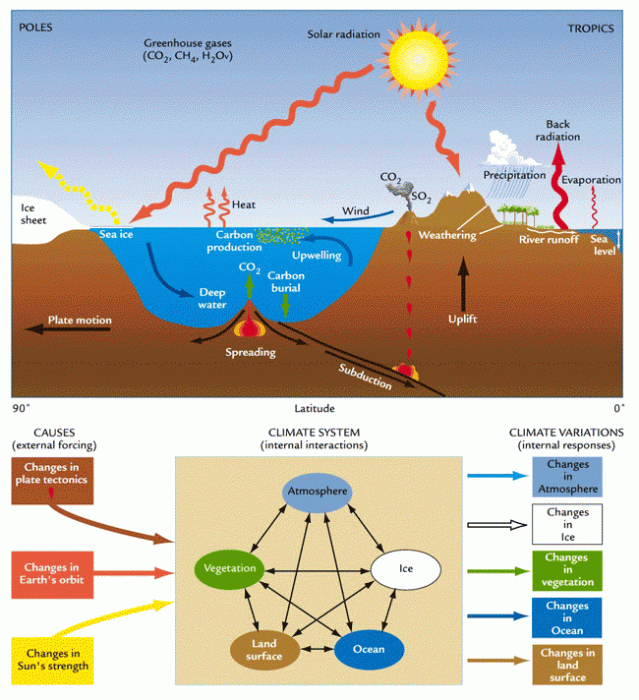The field of climate dynamics studies the processes that control the climate system and how it evolves. The climate system is controlled by the interaction of the atmosphere, the oceans, the land surfaces, the cryosphere, and the biosphere, averaged over time-scales of weeks to centuries and millennia. Climate can be classified into spatial zones based on, for example, regional similarities in temperature and precipitation—these zones often contain similar biotic elements from region to region.
The primary energy that drives Earth's climate system and sustains life is solar heat and light. The amount of solar energy that reaches Earth’s surface varies because of latitudinal position on the planet, internal solar processes, changes in Earth's orbit, Earth's albedo, changes on Earth such as major volcanic eruptions of dust that block the incoming solar energy, or changes in atmospheric composition. Earth's energy balance is complex. About 30% of incoming solar energy is reflected back to space, with 70% being absorbed by the atmosphere and surface of the planet.
To get a better overview of the climate system, there are three reading assignments I would like you to complete before we proceed. Once you have completed these three reading assignments, continue with this online lesson.
Reading Assignment
In succeeding portions of this lesson, you will explore some of the topics described in the chapter in more detail, but it is the generalized overview of the material presented in the chapter that I am most interested in seeing you master. On the first page of the chapter you will find a definition of the climate system as "an interactive system consisting of five major components: the atmosphere, the hydrosphere, the cryosphere, the land surface and the biosphere, forced or influenced by various external forcing mechanisms, the most important of which is the Sun." Confusingly, this sounds a lot like descriptions of the Critical Zone we read in Lesson 1! Remember: While the Critical Zone consists of portions of these "spheres," the central component of the Critical Zone is soil, the consequence of complex processes operating at the interface between the "spheres."
- Earth's Atmosphere
Before we begin to explore some of the intricacies of Earth's climate, I would like you to review some basic information about the structure and composition of Earth's atmosphere, available on NOAA's Web site. The terminology presented there will provide you with the background to better understand the remainder of the lesson. - Introduction in the IPCC Fifth Assessment Report: "Climate Change 2013 The Physical Science Basis"
This chapter provides an excellent description of climate entitled "Key concepts in Climate Science". Read the chapter, noting that:
- the glossary for the entire report is available at IPCC Glossary;
- the other chapters mentioned in the overview are available online but are not required reading for this lesson; and
- the final section of the chapter, entitled "A Road Map to this Report," is also not required reading for this lesson.
- Atmospheric Chemistry
The chemistry of Earth's atmosphere is governed by numerous complex reactions studied by atmospheric scientists. Though the next portion of Lesson 2 is primarily focused on the carbon cycle, I would first like you to explore some of the most basic concepts of atmospheric chemistry presented at Wikipedia.
Want to learn more?
(Optional) Read Chapter 10 (pp. 419–460) in
- Wallace, J. M. (2006). Climate Dynamics. In Atmospheric Science: An Introductory Survey, International geophysics series. (2nd ed.). Amsterdam: Elsevier Academic Press.
This chapter is available through Library Reserves. Do not focus on the details of this chapter and do not worry about references to earlier chapters, figures, etc. Your primary goal should be a very generalized understanding of the climate system, always considering in the back of your mind what implications this information may have to the Critical Zone.
Check out these Climate Education Modules for teachers. The website was created and is hosted by North Carolina State University, and pays particular attention to the southeast of the U.S. However, the website provides links to relevant National Science Education Standards and many pages include classroom activities.
